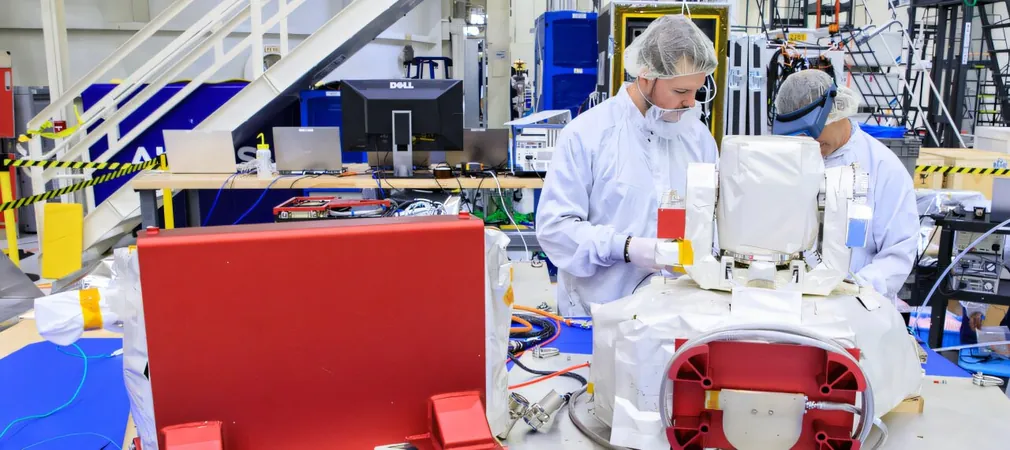
NASA's Artemis II Mission Set to Make History with Groundbreaking Laser Communication
2024-11-04
Author: Rajesh
Introduction
In an era marked by extraordinary advancements in space exploration, humanity is poised to return to the Moon after more than 50 years. The Apollo 11 mission, which saw astronaut Neil Armstrong take his iconic first step on the lunar surface in 1969, initiated a new chapter in human history. However, after the final Apollo mission, Apollo 17, in 1972, human exploration of the Moon came to a standstill, hindered by a multitude of political and budgetary challenges.
But that is all about to change! NASA's Artemis II mission is slated to launch no earlier than September 2025, where four astronauts will embark on a groundbreaking journey to the Moon, marking the first crewed Moon flight since Apollo 17. The success of the uncrewed Artemis I mission in 2022, which tested the spacecraft Orion's capabilities, has set the stage for this historic voyage. Artemis II will not only lay the groundwork for Artemis III, aiming to establish a sustainable human presence on the Moon but ultimately prepare for future manned missions to Mars.
Laser Technology Takes Center Stage
What sets Artemis II apart is its commitment to revolutionizing communication technologies. This mission will demonstrate laser communication (lasercom) for the first time during a crewed lunar flight. Developed by researchers at MIT Lincoln Laboratory over the past two decades, this next-generation laser communication system is crucial for long-distance, data-heavy space missions.
As spacecraft venture deeper into space, the need for enhanced communication capabilities is paramount. Laser communication systems can transmit far more data compared to traditional radio waves, significantly improving efficiency and power consumption. This advancement means more room for scientific instruments and longer-lasting missions.
The Orion Artemis II Optical Communications System (O2O) will transmit high-resolution images and video of the lunar surface back to Earth, a stark upgrade from the grainy footage captured during the Apollo missions. O2O will also facilitate high-speed data exchanges, procedures, and voice communications between the crew and mission control.
Equipped to transmit information at speeds of up to 260 megabits per second (Mbps), O2O will use laser beams directed at ground stations located at either the White Sands Test Facility in New Mexico or NASA's Jet Propulsion Laboratory's Table Mountain Facility in California—both chosen for their ideal cloud conditions.
At the heart of O2O is the advanced Modular, Agile, Scalable Optical Terminal (MAScOT), developed by Lincoln Laboratory. Packed with sophisticated technology, including a 4-inch telescope and cutting-edge optics, the MAScOT system is designed to track and maintain the laser connection, ensuring uninterrupted communication.
Paving the Way for Future Connections
The groundwork laid during the testing of the ILLUMA-T system in 2023, which successfully demonstrated two-way laser communications with NASA's LCRD satellite, represents a significant leap forward. This successful relay marks a critical milestone in the initiative, showcasing the technology's capability to handle high-speed data transfers essential for lunar and Martian missions.
Jade Wang, a co-principal investigator, emphasizes that the success of ILLUMA-T sets the stage for streaming HD video from the Moon, providing astronauts with advanced communication, medical support, and the ability to share their epic journey back to Earth. Imagine the incredible sight of astronauts utilizing videoconferencing to connect with experts while exploring the lunar landscape—a true testament to modern space exploration.
As Artemis II approaches its launch date, rigorous pre-mission testing is ongoing to ensure everything is ready for the operation. From command functions to user application trials simulating real-time data transfer, the focus remains on making the optical connection viable and beneficial for the astronauts onboard Orion.
Farzana Khatri, the lead systems engineer, highlights the significance of this optical link for data transfer. "We should be able to get data down to Earth within a few hours for immediate analysis. Furthermore, astronauts can stay in touch with Earth during their journey, inspiring the public and future generations of explorers."
Conclusion
Don't miss the chance to witness history in the making as NASA prepares for its Artemis II mission—this journey could redefine humanity’s presence beyond our home planet and lay the foundation for interplanetary exploration. The return to the Moon is not just a mission; it’s a pivotal moment in our quest to reach for the stars!
 Brasil (PT)
Brasil (PT)
 Canada (EN)
Canada (EN)
 Chile (ES)
Chile (ES)
 España (ES)
España (ES)
 France (FR)
France (FR)
 Hong Kong (EN)
Hong Kong (EN)
 Italia (IT)
Italia (IT)
 日本 (JA)
日本 (JA)
 Magyarország (HU)
Magyarország (HU)
 Norge (NO)
Norge (NO)
 Polska (PL)
Polska (PL)
 Schweiz (DE)
Schweiz (DE)
 Singapore (EN)
Singapore (EN)
 Sverige (SV)
Sverige (SV)
 Suomi (FI)
Suomi (FI)
 Türkiye (TR)
Türkiye (TR)